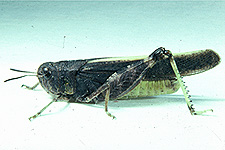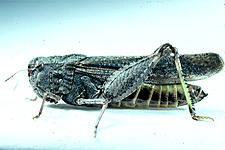Grasshoppers of Wyoming and the West
Entomology
Arphia conspersa (Scudder)
 |
 |
| Adult male | Adult female |
Common name - Speckled rangeland grasshopper (Helfer, 1972).
Geographic distribution - Alaska to Colorado, Utah, New Mexico and Arizona; east to Minnesota, Iowa and Nebraska (Brooks, 1958). In Colorado it is widespread at all altitudes (Hebard, 1929).
Habitat - forest clearings and grasslands. A. conspersa prefers sandy or gravelly soil (Brooks, 1958).
Food habits - a mixed feeder, preferring grasses and sedges, especially needlegrass, western wheatgrass, needleandthread, sixweeks fescue, bluegrass and Junegrass. It also eats cheatgrass brome, crested wheatgrass, Russian thistle, sand dropseed, Indian ricegrass, threeawn, belvedere summer cypress, scarlet globemallow, fringed sage, fourwing saltbush, rush skeleton-plant and prickly pear (Kumar et al., 1976; Mulkern et al., 1964; Mulkern et al., 1969; Ueckert and Hansen, 1971).
Eggs - eggs are deposited 13 to 20 per pod. They are light brown with prominent reddish-brown thickenings. Eggs are arranged in two or three columns within the pod. Average egg length, 4.1 mm; average diameter, 1.1 mm (Ball et al., 1942; Onsager and Mulkern, 1963).
Nymph - five instars (Ramsay, 1964).
Adult - medium size. General color is dark greyish-brown. Face is vertical. Vertex is rounded.
Top of head and pronotum are finely textured. Antennae are slender, gradually widening
toward the tip. Dorsal posterior margin of pronotum forms a rounded, right angle.
Median carina of pronotum is slightly notched near the middle. Tegmina often have
a pale, dorsal stripe. Wings are red or yellow bordered with black. Abdomen is conspicuously
yellow. Hind femora are robust: the inner face is black on the basal half, and yellow
with a black band on the distal half. Hind tibiae are light yellow to blue. Male length,
25 mm; female, 30 mm (Ball et all., 1942; Hewitt and Barr, 1967).
Flight is loud (Criddle, 1933a).
Seasonal history - eggs are produced in summer and hatch in August. Overwintering is in nymphal stages. Adults are present from mid-May to mid-July (Mulkern et al., 1964; Mulkern et al., 1969; Newton et al., 1954). A. conspersa may have a two-year life cycle (Hewitt and Barr, 1967).
Abundance and importance - eats valuable forage grasses but rarely becomes numerous (Mulkern et al., 1969).
A. conspersa fact sheet
Next Species: Arphia pseudonietana
Previous Species: Anabrus simplex
Biology of Common Colorado Grasshoppers List
Biology of Common Colorado Grasshoppers
Grasshoppers of Colorado Contents

